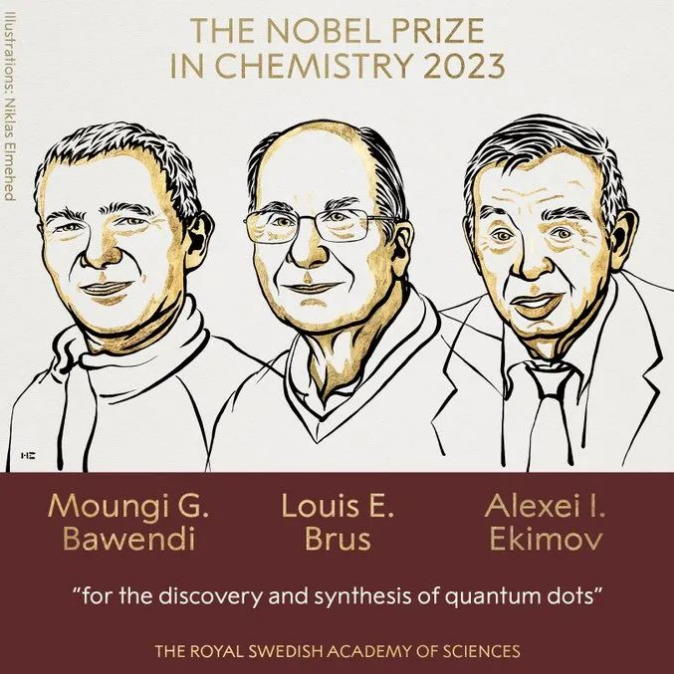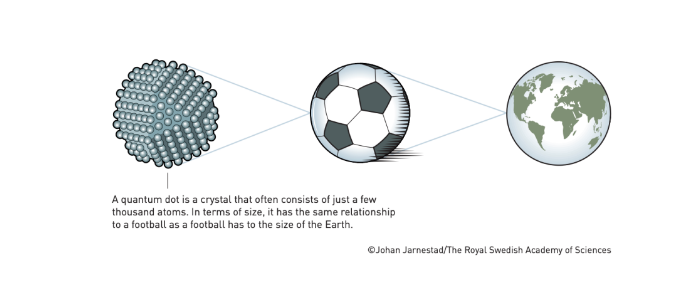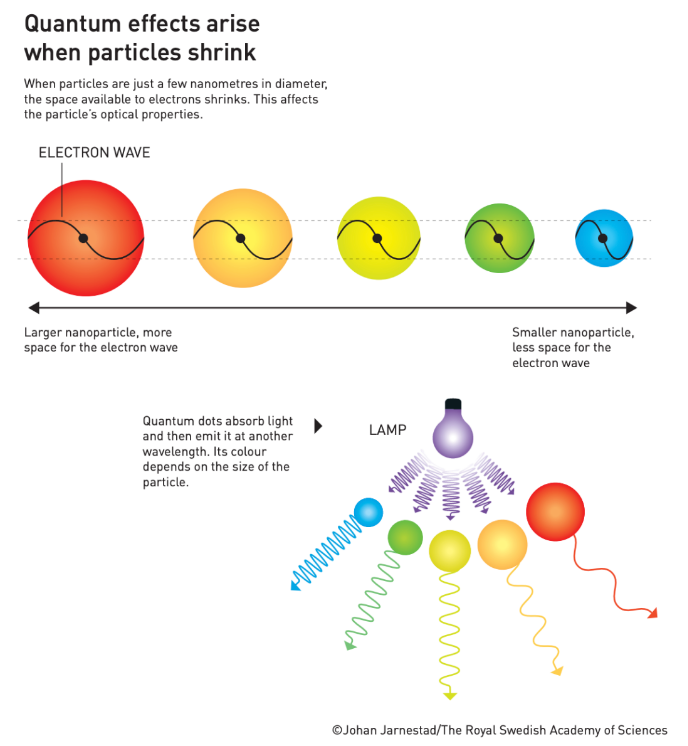


4 October 2023
The Royal Swedish Academy of Sciences has decided to award the Nobel Prize in Chemistry 2023 to
Moungi G. Bawendi
Massachusetts Institute of Technology (MIT), Cambridge, MA, USA
Louis E. Brus
Columbia University, New York, NY, USA
Alexei I. Ekimov
Nanocrystals Technology Inc., New York, NY, USA
“for the discovery and synthesis of quantum dots”
The Nobel Prize in Chemistry 2023 rewards the discovery and development of quantum dots, nanoparticles so tiny that their size determines their properties. These smallest components of nanotechnology now spread their light from televisions and LED lamps, and can also guide surgeons when they remove tumour tissue, among many other things.
Everyone who studies chemistry learns that an element’s properties are governed by how many electrons it has. However, when matter shrinks to nano-dimensions quantum phenomena arise; these are governed by the size of the matter. The Nobel Laureates in Chemistry 2023 have succeeded in producing particles so small that their properties are determined by quantum phenomena. The particles, which are called quantum dots, are now of great importance in nanotechnology.
“Quantum dots have many fascinating and unusual properties. Importantly, they have different colours depending on their size,” says Johan Åqvist, Chair of the Nobel Committee for Chemistry.
Physicists had long known that in theory size-dependent quantum effects could arise in nanoparticles, but at that time it was almost impossible to sculpt in nanodimensions. Therefore, few people believed that this knowledge would be put to practical use.
However, in the early 1980s, Alexei Ekimov succeeded in creating size-dependent quantum effects in coloured glass. The colour came from nanoparticles of copper chloride and Ekimov demonstrated that the particle size affected the colour of the glass via quantum effects.
A few years later, Louis Brus was the first scientist in the world to prove size-dependent quantum effects in particles floating freely in a fluid.
In 1993, Moungi Bawendi revolutionised the chemical production of quantum dots, resulting in almost perfect particles. This high quality was necessary for them to be utilised in applications.
Quantum dots now illuminate computer monitors and television screens based on QLED technology. They also add nuance to the light of some LED lamps, and biochemists and doctors use them to map biological tissue.
Quantum dots are thus bringing the greatest benefit to humankind. Researchers believe that in the future they could contribute to flexible electronics, tiny sensors, thinner solar cells and encrypted quantum communication – so we have just started exploring the potential of these tiny particles.
The illustrations are free to use for non-commercial purposes. Attribute ”© Johan Jarnestad/The Royal Swedish Academy of Sciences”



Moungi G. Bawendi, born 1961 in Paris, France. PhD 1988 from University of Chicago, IL, USA. Professor at Massachusetts Institute of
Technology (MIT), Cambridge, MA, USA.
Louis E. Brus, born 1943 in Cleveland, OH, USA. PhD 1969 from Columbia University, New York, NY, USA. Professor at Columbia University, New York, NY, USA.
Alexei I. Ekimov, born 1945 in the former USSR. PhD 1974 from Ioffe Physical-Technical Institute, Saint Petersburg, Russia. Formerly Chief Scientist at Nanocrystals Technology Inc., New York, NY, USA.
粗翻仅供参考:
10月4日,瑞典皇家科学院决定将2023年诺贝尔化学奖授予Moungi G. Bawendi、Louis E. Brus和Alexei I. Ekimov,以表彰他们“实现了量子点的发现与制备”。
他们为纳米技术埋下了重要的种子
2023年诺贝尔化学奖奖励量子点的发现和发展,量子点是非常微小的纳米粒子,它们的大小决定了它们的性质。这些纳米技术的最小组成部分现在从电视和LED灯中传播光线,还可以指导外科医生切除肿瘤组织,以及其他许多事情。
每个学化学的人都知道,一种元素的性质是由它有多少电子决定的。然而,当物质缩小到纳米尺度时,就会出现量子现象;这些都是由事物的大小决定的。2023年诺贝尔化学奖得主成功地制造出了小到其性质由量子现象决定的粒子。这种被称为量子点的粒子在纳米技术中非常重要。
“量子点有许多迷人而不寻常的特性。重要的是,它们的颜色取决于它们的大小,”诺贝尔化学委员会主席Johan Åqvist说。
物理学家早就知道,理论上,纳米粒子中可能出现与尺寸有关的量子效应,但当时几乎不可能在纳米尺度上进行雕刻。因此,很少有人相信这些知识会付诸实践。
然而,在20世纪80年代早期,阿列克谢·艾基莫夫成功地在有色玻璃中创造出了依赖于尺寸的量子效应。这种颜色来自氯化铜的纳米颗粒,Ekimov证明了粒子大小通过量子效应影响玻璃的颜色。
几年后,路易斯·布鲁斯(Louis Brus)成为世界上第一位证明在流体中自由漂浮的粒子存在大小依赖的量子效应的科学家。
1993年,Moungi Bawendi彻底改变了量子点的化学生产,产生了几乎完美的粒子。这种高质量对于它们在应用中使用是必要的。
量子点现在照亮了基于QLED技术的电脑显示器和电视屏幕。它们还为一些LED灯的光线增添了细微差别,生物化学家和医生用它们来绘制生物组织图。
因此,量子点给人类带来了最大的好处。研究人员相信,在未来,它们可以为柔性电子产品、微型传感器、更薄的太阳能电池和加密量子通信做出贡献——所以我们才刚刚开始探索这些微小粒子的潜力。
声明:化学加刊发或者转载此文只是出于传递、分享更多信息之目的,并不意味认同其观点或证实其描述。若有来源标注错误或侵犯了您的合法权益,请作者持权属证明与本网联系,我们将及时更正、删除,谢谢。 电话:18676881059,邮箱:gongjian@huaxuejia.cn